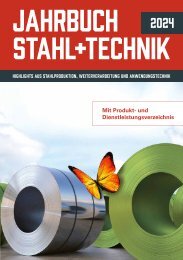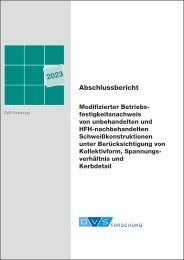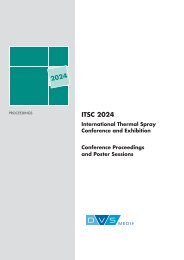STEEL + TECHNOLOGY 01/2020 EXTRACT
STEEL + TECHNOLOGY 01/2020 EXTRACT
STEEL + TECHNOLOGY 01/2020 EXTRACT
You also want an ePaper? Increase the reach of your titles
YUMPU automatically turns print PDFs into web optimized ePapers that Google loves.
58 | <strong>STEEL</strong> PROCESSING<br />
Hot forming of fastener heads and pins<br />
Three-die press accelerates hot heading by<br />
up to 30 per cent<br />
A newly developed upsetting press has been designed with three positions of the die. Hence, it chronologically<br />
separates the “inserting”, “heating”, “heading”, “cooling” and “discharging” operations from each other. This<br />
enables the machine to reduce cycle times by up to 30 per cent.<br />
Up to now, it has been customary to<br />
use dies with two opposing mountings<br />
for hot heading of fasteners<br />
(screws/bolts), ejector pins for mould-making<br />
and perforating pins and needles. A<br />
new pin was inserted in the upper position<br />
while the pin in the lower position was<br />
being headed. The die was then turned<br />
through 180°, the pin cooled down and<br />
was then discharged. Insertion, cooling<br />
and discharge all took place in the same<br />
mounting, with the result that the sum of<br />
these operations determined cycle time.<br />
The consequence: it was necessary to<br />
wait for sufficient cooling, particularly in<br />
the case of thick material, despite the fact<br />
that heating-up and heading had long since<br />
been completed.<br />
To overcome the obstacle and speed up<br />
cycle time, special-machine manufacturer<br />
Krott + Heuter has developed the ZKSTA<br />
series of automatic hot heading machines.<br />
It features a newly developed star die with<br />
three separately cooled mountings<br />
arranged in a star configuration. While a<br />
finished pin is being removed from the first<br />
position and a new one inserted, another<br />
pin is being inductively heated and upset<br />
simultaneously in the second position. The<br />
pin cools in the third position. The star<br />
rotates by 120° to the next position after<br />
each cycle. The process that determines<br />
cycle-time is now heating up, and there is<br />
no longer any need to wait through the<br />
unproductive cooling phase.<br />
Users report that they have been able<br />
to boost the output of their production<br />
lines by up to 30 percent thanks to the separation<br />
of heading, cooling and discharge.<br />
The new machine has now passed its trials<br />
at a renowned manufacturer of punches<br />
and ejector pins.<br />
The technology in detail<br />
The machine described above upsets pins<br />
of diameters between 2 and 8 mm with an<br />
upsetting force of up to 200 kN, although<br />
significantly larger dimensions and upsetting<br />
forces, of up to 1,000 kN, are also possible.<br />
The machine’s high level of precision<br />
also permits the production of fastener<br />
heads with special geometries, such as<br />
types bevelled on one side, for example,<br />
or pins featuring various special head<br />
shapes. The automated machine can also<br />
be used for cold upsetting of softer materials,<br />
such as structural steel, aluminium or<br />
brass.<br />
The pins are automatically inserted,<br />
measured and upset to the precise final<br />
head dimension by means of a servo-controlled<br />
stop plate, with the result that every<br />
individual head is completely filled.<br />
The servo-hydraulically actuated<br />
upsetting cylinder can be operated power-controlled<br />
or deformation-controlled.<br />
Unlike conventional systems, which<br />
require large quantities of hydraulic fluid,<br />
the new system does not include any<br />
external fluid supply. There is no separate<br />
tank for hydraulic fluid, and the machine<br />
therefore has a footprint of only around<br />
1.0 m × 3.0 m.<br />
These heading units have maintenance<br />
intervals of around 20,000 operating<br />
hours. Technically, they are automatic<br />
upsetting machines and are thus not subject<br />
to European mechanical and hydraulic<br />
press legislation.<br />
• Krott + Heuter GmbH, Stolberg,<br />
Germany<br />
The end of the pin is inductively heated and then pressed into<br />
the die by the heading cylinder (left). (Picture: Krott + Heuter)<br />
<strong>STEEL</strong> + <strong>TECHNOLOGY</strong> 2 (<strong>2020</strong>) No. 1


















